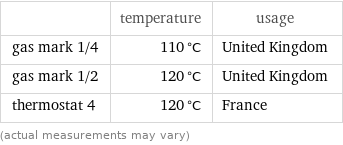Input interpretation

4-bromo-2-(trifluoromethyl)phenyl isocyanate | boiling point
Result

115 °C (degrees Celsius) (measured at 1333 Pa)
Unit conversions

388.2 K (kelvins)

239 °F (degrees Fahrenheit)

698.7 °R (degrees Rankine)

92 °Ré (degrees Réaumur)

67.88 °Rø (degrees Rømer)
Comparisons as temperature

12 °C below hottest temperature of a Concorde nose tip (127 °C)

15.02 °C above water boiling point (at standard pressure) (99.9839 °C)

95 °C above conventional US room temperature (68 °F)
Corresponding quantities

Thermodynamic energy E from E = kT: | 33 meV (millielectronvolts)

Blackbody energy flux Φ from Φ = σT^4: | 1287 W/m^2 (watts per square meter)

Approximate luminous exitance from a planar blackbody radiator perpendicular to its surface: | 7.6×10^-15 lx (lux)
Nearest corresponding gas marks

| temperature | usage gas mark 1/4 | 110 °C | United Kingdom gas mark 1/2 | 120 °C | United Kingdom thermostat 4 | 120 °C | France (actual measurements may vary)